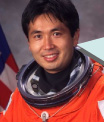|
|||||
| << August | October >> |
This is JAXA's Japanese astronauts' primary activity report for September 2004.
 |
| Astronaut Wakata at the Lecture |
 |
| Children asking many questions. |
Between September 20 to 22 Astronaut Wakata and Prof. Toshibumi Sakata, Chair and CEO of Advanced Earth Science and Technology Organization (AESTO), gave a lecture to the Japanese School students and Beijing Foreign Studies University's students who are studying Japanese. Approximately 1400 students attended these lectures in Beijing and Shanghai China.
Mr. Sakata's topic was an explanation of Earth Observation using a 1/100,000,000 scale (about 12cm in diameter) globe. Astronaut Wakata talked about the ISS and the Japanese Experiment Module "Kibo." Astronaut Wakata also told of his space flight experience on STS-72 and STS-92.Astronaut Wakata described what he had learned from his experience working with astronauts from various countries who are participating in the ISS Program.
- Beyond national boundaries and race, the values and cultures of Earthlings are quite apparent as people collaborate to widen the range of activities in space.
-It is important to have a balance between competition and cooperation in order to achieve improvements in science and technology, which will ultimately be beneficial to the entire human race.
The students asked questions such as "How do you eat and brush your teeth in space?", "How can I become an astronaut?" and "Are there any aliens out there in Space?"The lecture was very lively.
 |
This was my first visit to China.I was impressed with the city of the future , especially Shanghai, and their use of a magnetic levitation train.I also felt the Japanese school students at Shanghai and Beijing had a strong interest in the space program, as well as, the members from Japan Chamber of Commerce and Industry, and the students of BeijingForeignStudiesUniversity. I had an opportunity to visit the Great Wall of China prior to my return to Japan. I would like to get a closer look at the Great Wall from aboard the ISS in the future. |
In September, Astronauts Furukawa, Hoshide, and Yamazaki continued with their Space Shuttle Mission Specialist training.
The primary training in September was the T-38 aircraft flight training and on-site training at NASA's facilities.
 |
| Astronaut Hoshide climbing into T-38 |
The astronauts began their flight training after receiving a lecture on the T-38 system.The T-38 jet is a two-seater flight training supersonic aircraft equipped with two jet engines. For a long time, the T-38 has been used by the U.S. Air Force to train fighter pilots. This training was conducted under stressful aircraft flight conditions by having the candidates perform several tasks simultaneously, such as communicating with ground control, checking instruments and maneuvering the aircraft. This training was intended to increase their multitask abilities and to develop the crew coordination capabilities essential for space flight.
For an MS candidate more than 100 hours per year of T-38 flight training is mandatory for the first two years. After two years, 48 hours per year of the training is mandatory. Training will still continue even after being qualified as an MS. The astronauts’ training has just begun and will continue to enhance their skills through the training on instrument flight, night flight, formation flight and long-distance flight.
The candidates visited NASA Headquarters, Goddard Space Flight Center and Glenn Research Center. The candidates listened to an explanation on the continuing organizational reform at NASA and learned about the research and testing activities for the return to flight. They also visited a laboratory for the Hubble Robotic Repair Mission at the Goddard Space Flight Center, and observed the development of technologies that will be used to manipulate the robot arm in space from Earth.
Astronaut Mukai attended the second meeting of the Japan-China Committee for New Friendship in the 21st Century that was held in Tokyo on Sept. 19 and 20. The purpose of the Japan-China Committee for New Friendship in the 21st Century was to discuss the development of a relationship between the two countries. While Astronaut Mukai was attending this meeting, she had the opportunity to speak with Astronaut Yang Liwei, China’s first Astronaut to go to space.
International matters involving both countries and issues common to the both countries were discussed. Both sides agreed that the Japan-China relationship is of importance, and both countries must strive to develop and enhance the relationship based upon mutual trust.
 |
| Astronaut Doi and Associate Executive Director Matogawa hosting the meeting |
The second JAXA town meeting was held in Maebashi Terrsa, Maebashi City, Gunma Prefecture, on Sept. 19. The JAXA town meeting was an occasion to exchange opinions and to create a greater public awareness of JAXA's space activities. The first JAXA town meeting was held in Miyazaki Prefecture on May 29. Additional town meetings are planned in various cities of Japan. Astronaut Doi and Associate Executive Director Matogawa hosted the meeting. They engaged in an active discussion with about 400 participants in attendance at the meeting regarding future space developments and JAXA's public relation topics.
| << August | October >> |

|